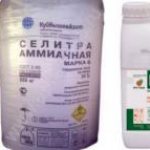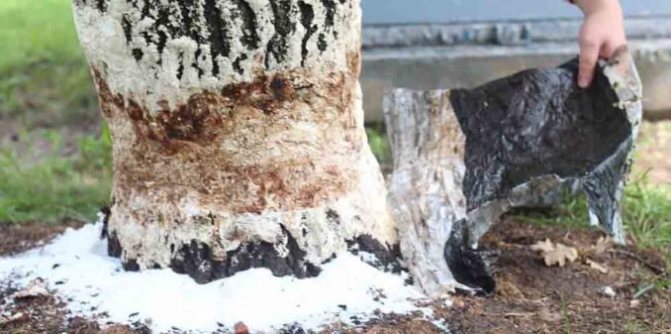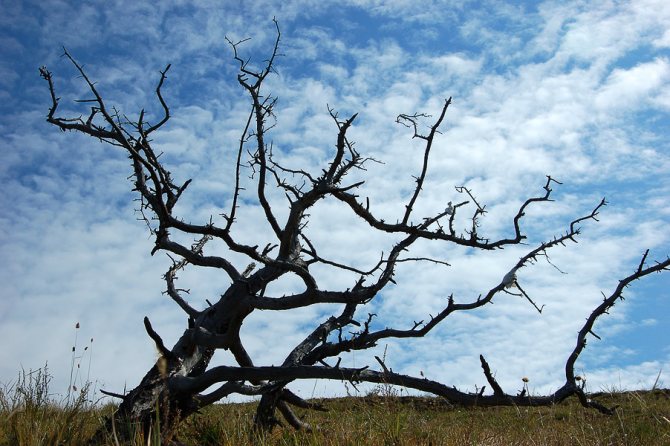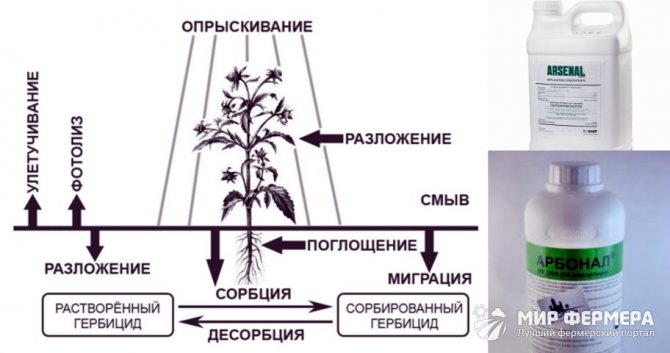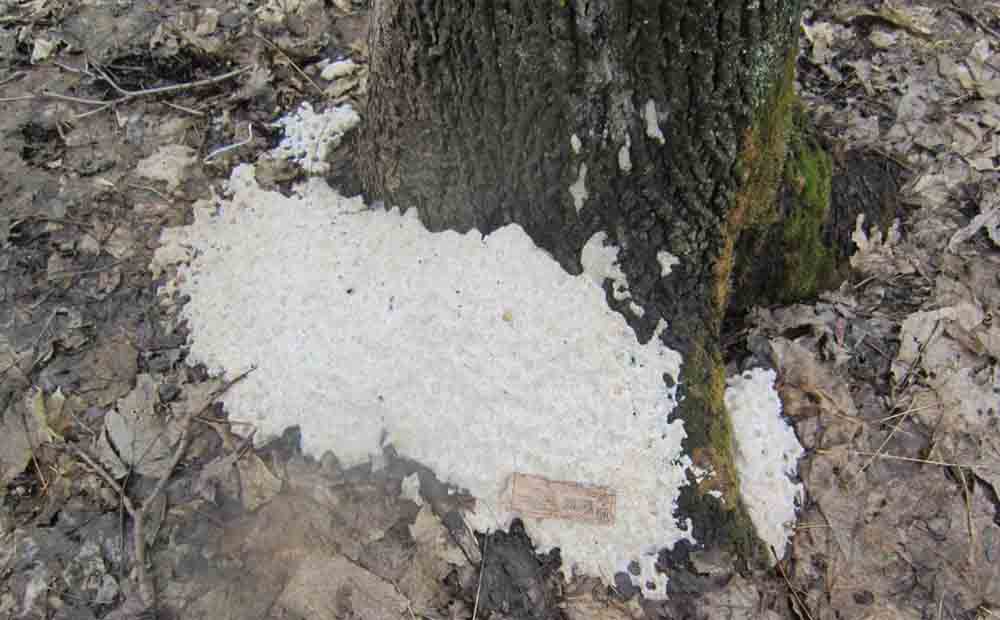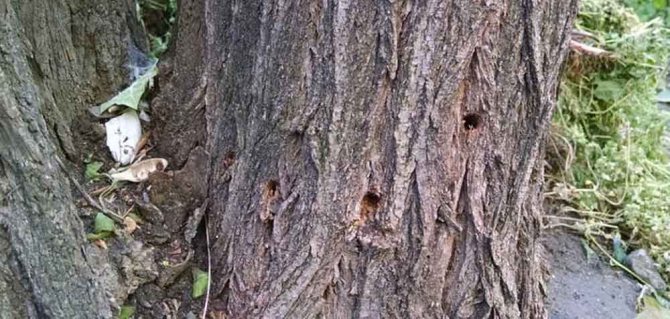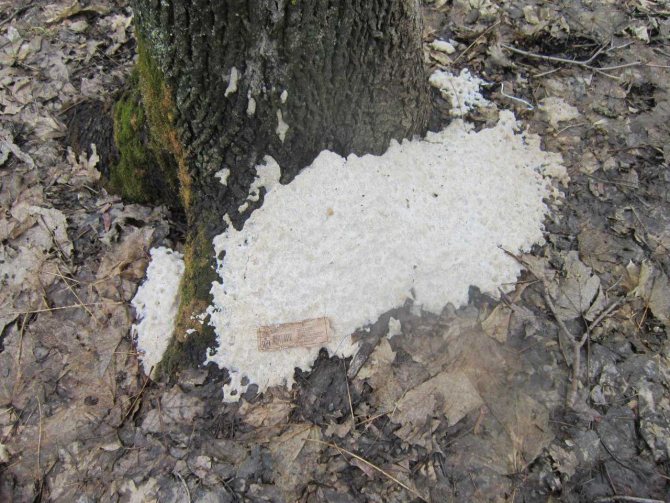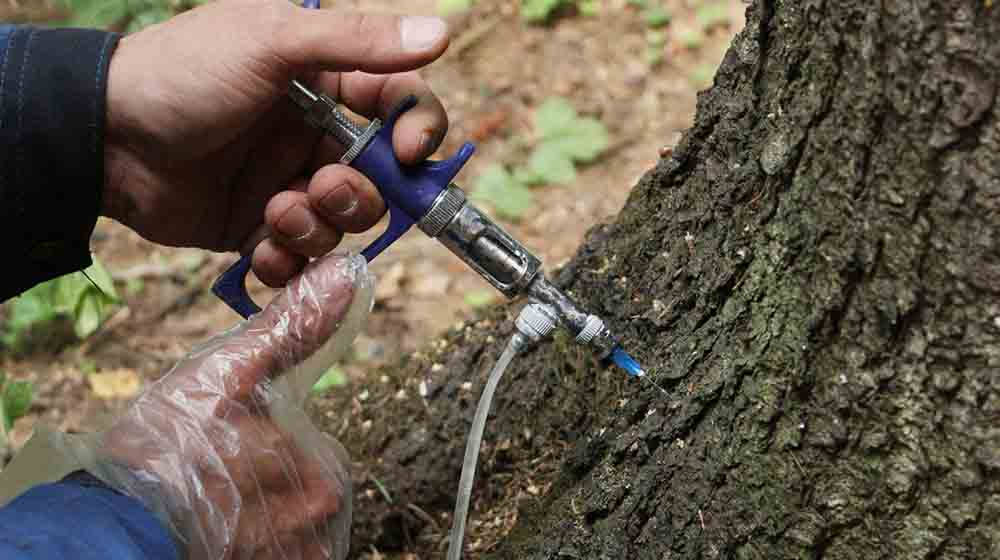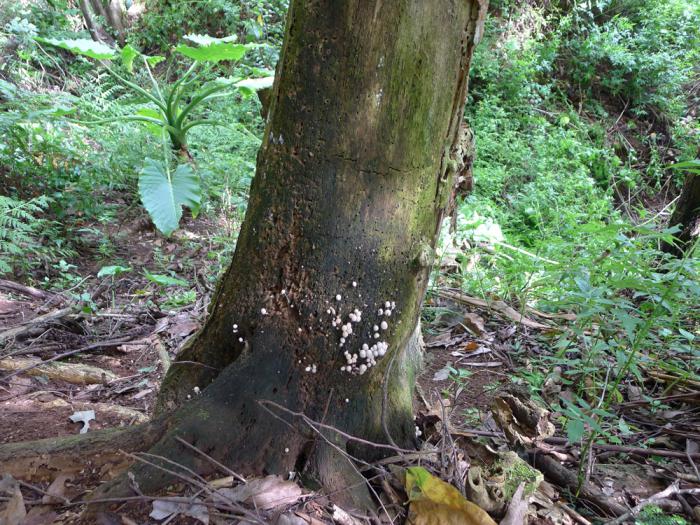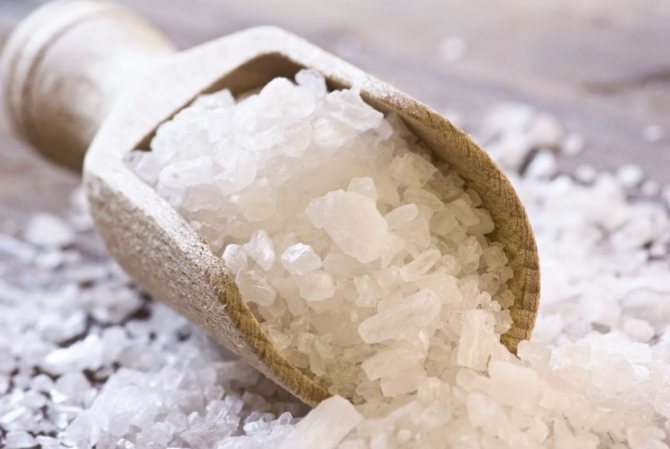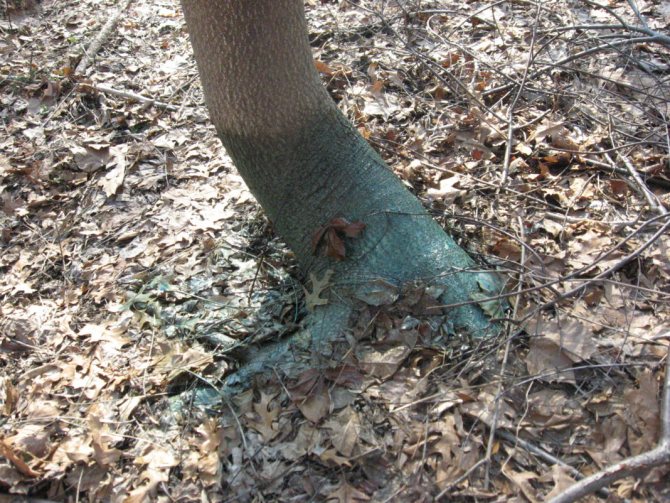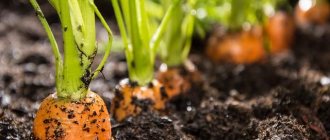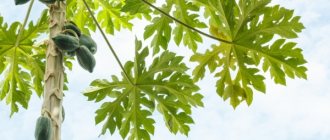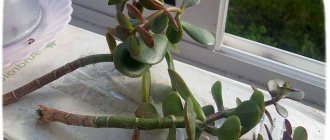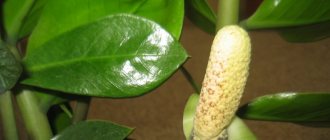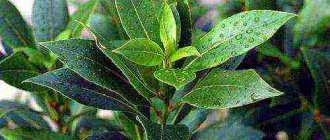Than to water a tree so that it perishes. How to water the tree so that it dries quickly?
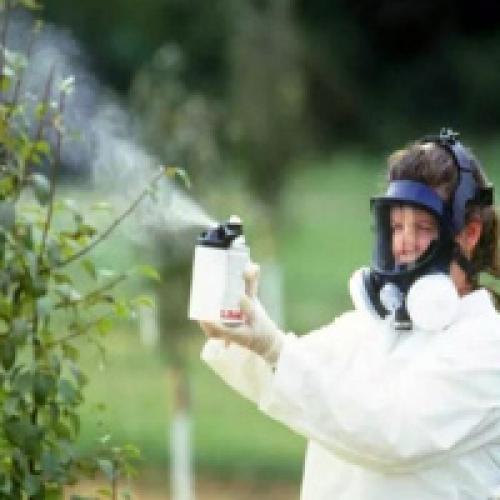
Each gardener plans the placement of trees and shrubs on his site to create a beautiful landscape and comfort. Naturally, in the process, the thought does not come to mind at all that there will be a need to destroy the landings. Unfortunately, this happens quite often. If a tree is sick or has grown so much that it poses a threat to human lives or the integrity of buildings, it must be eliminated.
It is not always possible to just cut the trunk. In this case, special chemicals are used. They need to water the tree so that it dries up, and it is easier to cut it into pieces and remove it from the site. In this article, you will learn what substances can be used for these purposes.
How to make a tree dry
There are many ways to artificially dry a tree, both scientifically based and folk. Chemicals are considered more effective, which, although they pose a certain danger to the soil and humans, still allow even a large specimen to dry quickly.
There are several ways to destroy garden trees:
- Watering the leaves and bark with a solution of chemicals;
- Application of special preparations on sheet plates;
- Inoculation of poisonous substances that quickly penetrate the juices of the plant and destroy it;
- Placing the poison in the ground near the roots of the plant.
From the point of view of technology, the tree does not need to be destroyed: it is enough to simply cut it down, and treat the remaining stump with chemicals for destruction. However, if you need to act quickly, the advantage is still given to chemicals.
But, after the tree has dried up, it needs to be recycled. How to do it right - says the author
Tree killing chemicals
It is not difficult to destroy a tree with the help of chemicals, especially since every gardener has most of them (Figure 1).
The most effective remedies include:
- Sodium nitrate: Most commonly used to kill stumps, but it can also be used to target adult specimens. To make it dry in a year, you need to drill a hole in the barrel and inject a chemical into it. If this is not possible, you can simply water the soil around the plant with a solution of nitrate, but in this case, the drying process will take several years.
- Ammonium nitrate: it uses the same principle as sodium nitrate, but there are still certain differences between these substances. Ammonium nitrate is produced on the basis of urea, which accelerates the decomposition of wood, therefore it is most often used for treating stumps and open root systems.
- Pikloram: Another effective remedy that acts directly on the root system. The substance inhibits the roots and the culture gradually dries up.


Figure 1. Main chemicals for tree destruction: sodium nitrate, ammonium nitrate, Pikloram preparation
In addition, conventional herbicides can be used to destroy plantings, as well as special preparations, arboricides, which are designed specifically for treating trees and large shrubs. We will consider the features of the effect of these substances in more detail.
Arboricides
In fact, arboricides belong to the group of herbicides, as they are designed to control vegetation. The only difference is that arboricides are used exclusively for the destruction of trees and shrubs (Figure 2).
The substance must be diluted with water and the culture should be sprayed with a ready-made solution. The procedure is best done in early spring so that the substance does not accidentally get on other plants. However, if the need for processing arose in the middle of the season, it is better to use another method: drill a hollow in the trunk and place the preparation there. In this case, aroboricide will only affect the selected crop. At the same time, it is advisable not to plant and harvest at this place during the year.
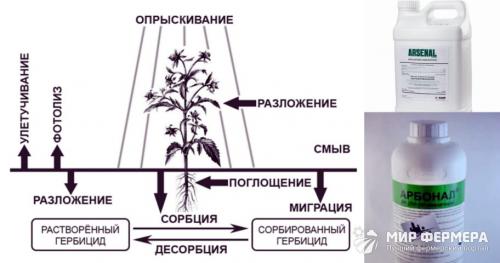

Destruction methods
How to destroy a tree without being noticed? It is not good to kill vegetation on the sly, but there are different situations. The most proven and effective method is the use of chemistry. Before pouring poison on the plant, pour a couple of buckets of water near it. This is necessary in order for the chemistry to penetrate deep into the soil and take out the roots.
There are various ways to destroy a tree in an area. They are described in our article. You can destroy an unnecessary tree in a short time if you follow all the recommendations of experienced gardeners. How to process the roots of trees so that they do not grow and when it is better to carry out the procedure - you will also learn about this from our article.
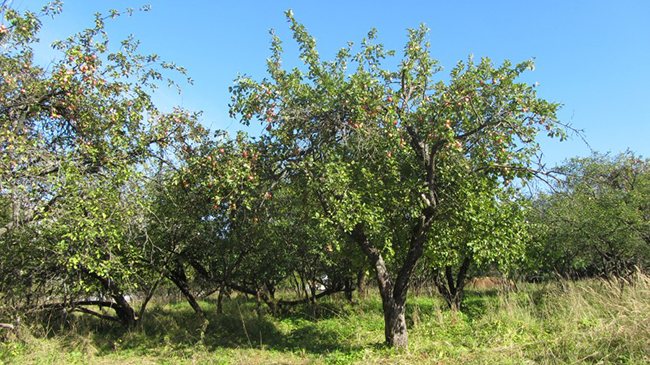

There are various ways to destroy a tree on a site.
Sprinkle salt water over the tree. Folk ways
Effective "old-fashioned" means, if the priority is sparing methods of renewing plantings.
Mulch
The option is relevant if the problem is solved, what to do and what to do so that the tree dries up for "natural" reasons. Mulching the trunk to a high height will help eliminate saplings with a sensitive root system. To do this, make a dump of crushed weed to a height of about 0.5 meters. Any mulch will do, including sawdust, hay, humus, peat.
You can also use potato peels, vegetable tops, fallen leaves, and other formulation options. The goal is to exclude oxygen from the root system. The lack of air circulation leads to accelerated decay, caustic substances and heat energy released in the process quickly corrode the bark. As a result, the roots die off and the tree dies.
Salt
Watering with a high concentration of brine is effective if you need to destroy a not very old tree. However, in order to eliminate a powerful culture, it will take a long and regular time and effort, and spend on the purchase of large amounts of salt. The solution is prepared in a 1: 1 ratio, watered from the beginning of the growing season until autumn frosts. If you wish, you can build a trench around the trunk, fill in salt, mask it on top with a layer of soil. After the tree dries up, the soil will have to be renewed. For the natural restoration of soil fertility, it takes several years to wait.
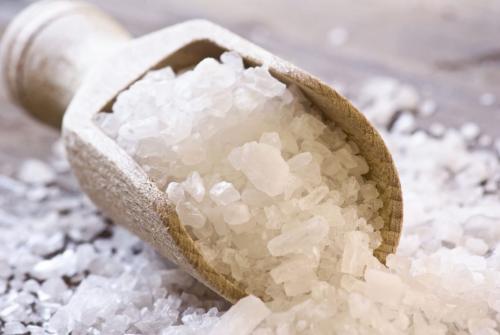

Salt is a folk remedy for withering wood
Concrete
To get rid of a powerful crown that interferes with the construction of, for example, a garden sidewalk, it is recommended to pave the roots. The procedure involves digging a circle around the perimeter of the trunk to a depth of 50-70 cm, depending on the nature of the root system. The prepared trench around the tree is poured with concrete mortar. At the same time, access to air and nutrients is blocked, which leads to the death of the roots.
Sodium saltpeter
It is also called potassium. Usually this option is used in relation to stumps, but you can also directly apply it to the soil layer or directly into the trunk. This is the best option for those who are looking for more than watering the tree to dry it up, among the folk methods.If the composition is introduced into an artificially created hollow, this will entail a more intensive drying process of the tree from the roots to the upper part of the crown. After about a year, the wood will lose its ability to live, and it can be burned. If standard watering with the composition is used, then drying can be delayed - but in any case, after a few years, the expected effect will be provided.
What happens if you pour salt water on a tree. How to kill an interfering tree quickly and easily?
Experienced gardeners recommend drilling an oblique hole in the trunk of such a length that it reaches the core of the trunk, and pouring liquid into it, which will begin to destroy the tree from the inside. It can be a strong acid - acetic, hydrochloric, formic. The acid kills the tree within a week.
Ask the railroad workers for a solution of dichlorophenoxyacetic acid, which they use to control shrubs and vegetation along the railroad tracks. This tool is also introduced into the hole drilled with an inclination.
You can pour gasoline, diesel fuel, acetone into the hole - the effect will be the same. Do not forget about herbicides - they destroy not only weeds, but also rather large trees. These are herbicides with Tornado glyphosphate, Arsenal and other products with a similar composition.
Herbicides are used in the same way as acids, after pouring in the killing liquid, the hole is closed with clay, putty, garden pitch so that the liquid does not evaporate.
To kill a tree, you can spray its leaves with Roundup, diluted in water in a strong concentration. First, the agent destroys the leaves, then dries up by itself, deprived of the possibility of photosynthesis and the production of necessary nutrients. Roundup can also be injected into a tree trunk in the same way as described above.
Experts recommend applying herbicides to the cuts in the bark of trees, but not in the spring, since the sap flow prevents the absorption of the drug.
In addition, herbicides are applied directly to the bark in the lower part of the trunk - at a distance of 30-50 cm from the ground. This procedure is carried out from spring to early autumn. To prevent the herbicide from draining from the bark, it is mixed with oil and the bark is coated with it.
There are special herbicides, for the destruction of large trees and shrubs arboricides, buy and apply them according to the instructions.
It is believed that a copper nail driven into it can easily and quickly kill a tree; perhaps a large tree cannot be destroyed with one nail, several nails will be needed.
A small tree can be destroyed by burying several old batteries next to it, but their acid is harmful and dangerous for all living things.
An interfering tree can be killed without cutting it down, with the help of salt - it is introduced in a solution with water - by watering the tree, or simply by burying it under the roots. It is desirable to add salt under the central root, but saline under the peripheral processes is also acceptable. At the same time, keep in mind that the roots of the tree grow unevenly - from the east side they stretch to a distance equal to the height of the crown, and from the west - half the height.
Using this feature of the root system, some summer residents are trying to destroy a neighbor's tree without penetrating into someone else's plot. They just bury salt at the fence next to the tree and that's it. At the same time, no efflorescence occurs on the soil, and it can be very difficult to prove their malicious intent. The salt method works for 1-2 months - first the tree sheds its leaves, and then dries up.
But, one should not forget that salt in the soil will negatively affect other plants, as well as water in a well or well. Water and soil are also polluted by other means applied directly under the roots - herbicides, gasoline, diesel fuel, acids. Therefore, you need to act with them thoughtfully and carefully.
There is an ecological method of "killing" a tree.Reliably, but not very quickly, it is killed by a decorative liana with a characteristic name - woodworm. This beautifully flowering vine twines around the trunk of a tree, attaches to it not with suckers or tendrils, like other vines, but with sharp thorns. As a result, the tree dies, and now it is important not to let it go to other, necessary and useful trees. The woodworm is used if it is not the tree itself that interferes, but its roots.
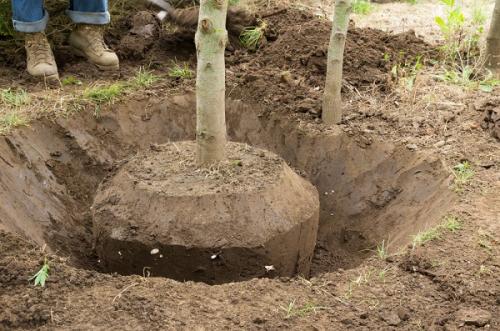

General rules
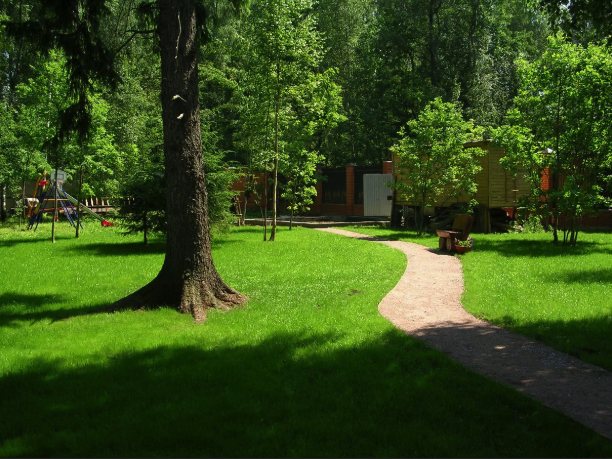

- It is worth doing this in spring and summer.when juices move along the trunk. In winter, the tree freezes, and the chemistry may not work (moreover, its traces will be clearly visible in the snow). In the summer, the same spraying will be ineffective due to the heat.
- When choosing chemistry, remember: some of its types can spoil the site. Therefore, if you kill a tree in a city courtyard or in a parking lot, you can pour whatever you want, but if in a garden, in a vegetable garden or in a private courtyard, it is better to use salt or only agricultural products.
- Many herbicides are poisonousso always hide them from children. Also, some (say, "Hurricane", which will be discussed below) may be harmless to pets and poultry, but real poison for fish, so do not use them near bodies of water.
- Herbicides work well on deciduous trees and very weakly for conifers.
- If the trees grow closely, their roots can grow together. This means that by exterminating one, you can hit the rest of the plants with chemistry.
- Salt - also an ambiguous assistant, because the salted area will not be fertile. However, when the tree dries up, the land can be improved. Look at the soil. If it is sandy, just water it well (in 4 times the salt will go down). If acidic, carry out liming. And most importantly, such actions will not seem suspicious to anyone.
- If you want to remove a tree in a thickened plantingwhere the roots of several plants are closely intertwined, it is best not to use chemical agents so as not to kill unnecessary trees. You should act when the ripening of the crop is over.
- It's worth starting with the most innocuous way: pour a bucket of boiling water under the roots, and another week later. This will definitely not harm the soil.
But choose a time at which you will definitely not be caught, because steam that compromises you will come from the ground for about 10 minutes.
Helpful hints
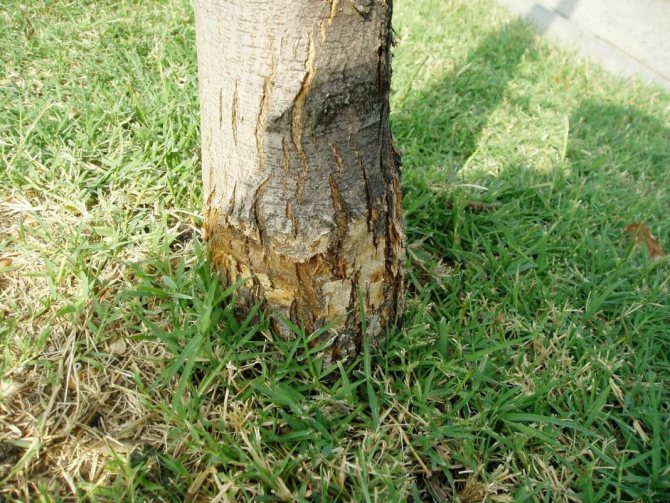

Below are some helpful tips to help you destroy the unwanted tree:
- Man destroying trees with chemicals, bears full responsibility for the final effect.
- Remember that machining accuracy can be improvedif a coloring agent is added to the herbicide. Trees after this treatment are much easier to track, therefore, you are unlikely to miss them when reprocessing (if any).
- Trees can cork cuts and damagethereby protecting yourself. In other words, a protective layer is formed around the damaged tissue, which can reduce the effectiveness of the drug used. For this reason, when using Method # 1, the chemical must be applied immediately after making the cuts.
- Herbicidereleased from the tree can be absorbed by neighboring plants. This should not be forgotten either.
- Some trees may have one vascular system (this is a consequence of root accretion). This often happens between members of the same species, but not always. Be that as it may, the herbicide can be transferred from the destroyed tree to the one that cannot be destroyed.
Short description
Myrtle is an evergreen decorative fragrant tree of the myrtle family with shiny dense dark green leaves. It begins to bloom at the age of about five years with fragrant inflorescences of light shades. Fruits with black edible berries. Myrtle leaves are capable of producing aromatic compounds and essential oils, emitting a subtle fragrant aroma into the environment, vaguely reminiscent of the smell of pine needles.


Drying wood in atmospheric conditions
The workpiece is boiled in water for several hours. After digestion, it is dried out away from sunlight.
For this purpose, a flat, dry area is selected on the site. The place should be elevated to avoid flooding. A flooring of poles is constructed on it, on which blanks are stacked.
The top row of a stack, be it round timber or planks, is laid with a slight slope and covered to protect it from both rain and sun. If a round timber of a coniferous tree is used for drying, then it is better not to remove the bark from it, otherwise, even covered, it will crack. To protect the ends of the round timber from rotting, they are treated with lime, liquid glue or sodium chloride solution.
This method allows you to take about 75% of the moisture initially in the wood. However, it cannot dry the tree quickly with it - the average drying rate can be taken as 1 cm per year. But this value depends on numerous factors: wood species, wood thickness and type, and weather conditions. Therefore, for a guarantee, it is better to assume that coniferous and soft deciduous wood dries for 1-1.5 years, and hard wood dries for 2 years or more.
Wood drying requirements
Wood drying methods: a - natural, b - in a low-temperature chamber, c - under high-frequency currents, d - in a condensation chamber.
Drying consists of 2 processes that take place in the tree at the same time. Moisture evaporates from the surface of the tree, and that which was originally inside the trunk moves from the center to its surface. The larger the workpiece, the longer it takes for the moisture to evaporate. For wood that will be used outdoors, the residual moisture should be between 12-18%. But if it is supposed to use wood or wood products in a heated room, then it will have to be additionally dried at room temperature. Residual moisture in it should not exceed 8-10%.
In production conditions, when drying wood, a special device is used to determine its moisture content - an electric moisture meter. But at home, there is no need to purchase such a device for a pair of blanks. The moisture content of wood can be quite accurately determined by touch. To do this, it is enough to squeeze a few wood chips in your hand. If the wood is dry, then the shavings in the hand will break, and if not, they will be compressed.
If you have to start harvesting wood, remember: the tree has the least moisture from the time it completely shed its leaves, and until the buds begin to swell on it. If you decide to prepare wood for further processing yourself, then it is better to do it during this period.
Let's take a closer look at the different ways of drying wood.
Back to the table of contents
The subtleties of determining the causes
As you know, 50% of a successful outcome for a tree depends on the correct diagnosis.
For a more correct diagnosis it is necessary to take into account:
- Soil condition,
- The proximity of groundwater,
- Their salinity,
- The presence or absence of elements and trace elements,
- Overwintering quality,
- Manifestation of various diseases.
Without this, it is impossible to say for sure what caused dry tops or another type of drying out of apple trees.
The reasons why apple trees dry up can be divided into three groups:
- Negative effects of atmospheric conditions (frost cracks, burns),
- Fungal diseases
- Pests cortex and cambium.
Prevention measures
Prevention for apple trees is simply necessary:
- So, cleaning fallen leaves on an autumn day is a prophylaxis against dispelling spores of putrefactive fungi and other infections. Not bad such the leaves burn, and then use campfire ashes as fertilizer when digging near-trunk strips.
- Disinfection instruments with chlorhexidine, treatment of wounds with varom is also prevention.
- Like killing weeds cleaning dead bark from the trunk.
- Spring treatment fungicide on swollen buds or copper preparations on the "green cone" of apple trees, and after flowering - a single treatment with broad-spectrum insecticides, also prevention.
- As well as timely feeding microelements.
Be careful with chemicals and don't use them when ripening apples!
Attention! A large introduction of "organic nitrogen" undermines the health of apple trees and makes them "tasty" for aphids!
How to remove the root after drying out
After the tree has dried up and it has been cut down, a stump remains on the surface, and roots are in the ground, which presents certain inconveniences to the owners of the site. For the fastest removal of stumps, two methods are used:
- applying the product to the cut itself;
- lubrication of notches.
For such work, 10% solution of butyl ether is very suitable. If you want to remove several stumps, then in this case use saltpeter. The procedure is carried out as follows:
- Holes are drilled in the remains of the wood.
- Fill them with saltpeter.
- All holes are closed with plugs.
The tree is left in this form until the next season. During this time, it will dry out thoroughly, after which it will be much easier to remove the stump and roots.
Removing a mature tree is a complex and time-consuming process. However, using the above techniques, it can be greatly simplified.

